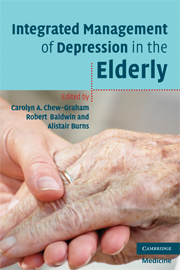Book contents
- Frontmatter
- Contents
- Contributors
- Foreword
- Preface
- Acknowledgements
- 1 Late-life depression: an introduction
- 2 Management of late-life depression
- 3 Management of late-life depression in primary care: case studies UK
- 4 Management of more complicated depression in primary care: case studies UK
- 5 Management of late-life depression across primary and secondary care: case studies UK
- 6 Management of late-life depression around the world: summary of international commentaries
- 7 Resources
- Appendix: International commentaries
- Index
- References
2 - Management of late-life depression
Published online by Cambridge University Press: 18 December 2009
- Frontmatter
- Contents
- Contributors
- Foreword
- Preface
- Acknowledgements
- 1 Late-life depression: an introduction
- 2 Management of late-life depression
- 3 Management of late-life depression in primary care: case studies UK
- 4 Management of more complicated depression in primary care: case studies UK
- 5 Management of late-life depression across primary and secondary care: case studies UK
- 6 Management of late-life depression around the world: summary of international commentaries
- 7 Resources
- Appendix: International commentaries
- Index
- References
Summary
Introduction
Most patients with depression are managed in primary care settings; however, a substantial number of patients are not recognized, and those who are diagnosed often do not receive effective treatment (Kessler et al. 1999). There is, however, a good evidence base for the management of depression in older people. Treatments that have been shown to work are the same as for younger adults: antidepressants, psychosocial and psychological interventions, or combinations of these and electroconvulsive treatment (ECT) for severe life-threatening or therapy-resistant cases. There is evidence to show that there are effective pharmacological (Wilson et al. 2001), psychological (Karel and Hinrichsen 2000) and psychosocial (Scogin and McElreath 1994) interventions for late-life depression, but these have yet to be adopted in primary care (Unützer 2002), in part because although cost-effective, they may involve added resource and investment to begin with. Only one in four depressed people receives effective pharmacological treatment and fewer than one in ten a talking therapy (Singleton et al. 2001). However, this is despite the fact that many people want and prefer ‘talking treatments’ (Rogers et al. 1993).
General principles of treatment
Goals of treatment
Table 2.1 provides a framework and summary of the goals for depression management (Baldwin et al. 2002).
Resolving all the symptoms of depression is the goal rather than getting the patient a bit better, as partial recovery is a predictor of future relapse.
- Type
- Chapter
- Information
- Integrated Management of Depression in the Elderly , pp. 17 - 32Publisher: Cambridge University PressPrint publication year: 2008
References
- 1
- Cited by



